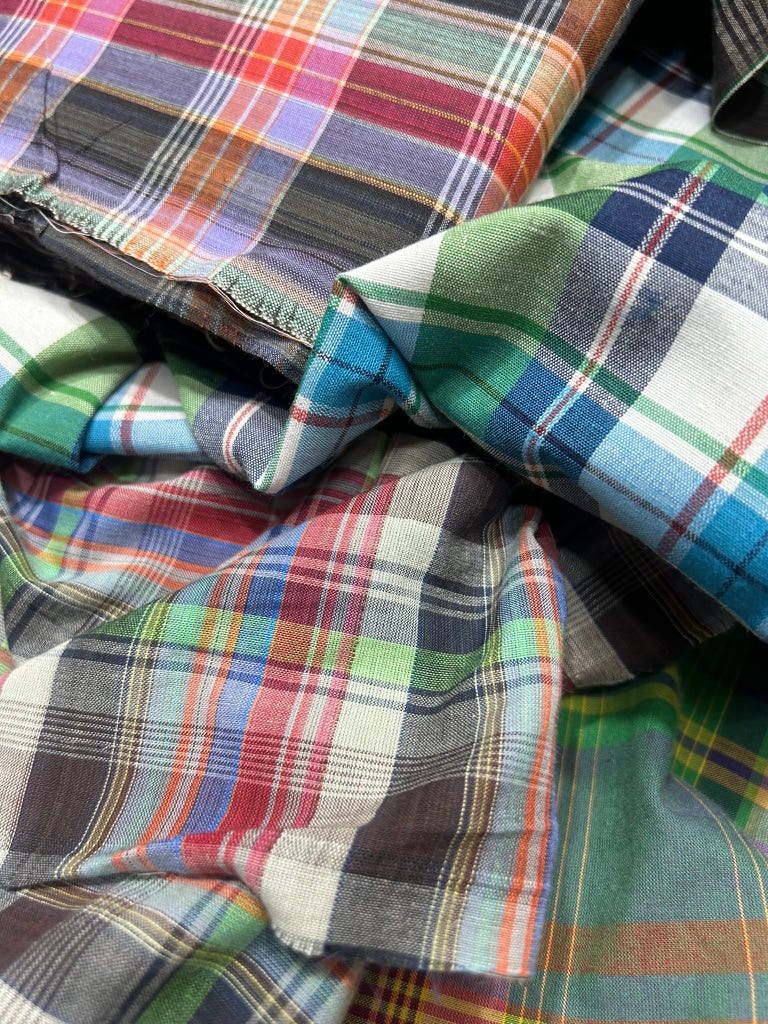Mad for Madras
Our Summer Fashion Guide
We’ve shared a broad clubby attire, but now that summer’s in full swing, ‘tis the time to revisit the subject.
In my mind, summer means one thing: bring out the madras. I am so madras-crazy that I even hosted a madras-themed party on my birthday and sported a Madras tuxedo. Mr. Robinson chose the more subtle option of a seersucker suit topped off with a madras necktie.
But you might be wondering, what in the world is madras?
Madras, now called Chennai, is an Indian port city where the lightweight, handwoven cotton originated. Whilst Indian textiles have always enjoyed stellar reputations, dating back from the Roman world, and were traded throughout the world, it was in 1718 that the fabric first reached American shores, as a donation to Yale College.
It took almost a quarter of a millennium for madras to become a ubiquitous staple of club attire. In 1958, an enterprising Indian exporter struck a deal with William Jacobson, a buyer for Brooks Brothers and other American firms, to sell the iconic fabric to the firm that has dressed American presidents and statesmen for centuries. David Ogilvy, of the eponymous advertising firm, transformed madras into a sensation with the phrase "guaranteed to bleed”, which referred to the bleeding of the dyes in the fabric from washing in hot water. Clearly washing instructions had been lost on the 9,000 mile journey from India to the United States. What was once a working-class fabric in India acquired elite connotations in the Anglosphere.
Where madras gets its checks from is lost to the mysteries of time. One plausible theory, according to Deb German, is that the plaid-tartan-esque patterns were riffs on Scottish regimental attire, but there’s no way of knowing how true that is. Madras, whether in patches, or as a single loomed and dyed fabric, retains its own vibrancy of patterns and hand-loomed blemishes.
Madras is perfect for the summer: it is bright, colourful, and playful. The variety in madras helps break the monotony of pastels that enjoy their high-water mark in the summers, and careful dressers will seek out unusual patterns to stand out without really standing out.
That being said, however, madras is far from the only summer staple at clubs—though it is by far my favourite.
Linen

Another great summer fabric is linen, which, much like madras, has enjoyed a resurgence in popularity. Made from the flax plant, and oftentimes with a light weave, linen is one of the oldest fabrics known to man. The growing of flax and the weaving of linen was brought over to the United States by colonists from the Old World, and was “the most commonly used fabric in the Colonial period”.
Linen’s long-staple fibers create a fabric that is soft to touch, and softens even more over time. A linen shirt can help you dress up whilst avoiding the sheen and the tackiness of a plasticky, polyester-filled “sport” or “tech” shirt. Linen pants and dresses are long-held club summer staples, in no small part because of their breathability and durability.
Polo Shirts

There’s the classic polo shirt, which, like most club staples, owes its origins to the British Raj. It’s simply too hot to put on a full shirt in India, and the game of polo rewards flexibility of arm movement. Thus was born the polo shirt, with a collar that wouldn’t flap in one’s face, and fewer buttons to contend with for a sleeker look. The polo shirt also shares a common origin with the OCBD’s button down collar, and the first polo shirts were made of the same oxford cotton fabric.
Today, polos are made in knit weaves, and while the white polo shirt rules the roost whilst sporting around clubland, they do double-duty on and off court. The expansion of “sport”-wear, especially in the golf world, centres around polos made in polyester and rayon weaves. While they are better at wicking away sweat, the sheen and the fall of the fabric are generally worse than their cotton counterparts.
Don’t Forget the Shoes
And last, but certainly not the least, is footwear. I’ve been admonished for my love of beat-up Sperrys, broken in and then some, and mumma’s attempts to replace them have been a source of friction. I happen to agree to disagree, and love them as staples. A good loafer—whether plain or penny—or Spanish-influenced espadrilles, with their woven rope around the sole, are fashionable alternatives. Shoes without socks are the quintessential summer look.
And, for the love of all things sacred to Clubland: no slippers, crocs, and sandals. If you show up to your club wearing those ghastly, horrid things, you’ll be hearing from us and, more specifically, me. Soon.

